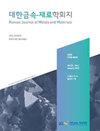腐蚀环境对制动器摩擦材料摩擦特性的影响
IF 1.4
4区 材料科学
Q4 MATERIALS SCIENCE, MULTIDISCIPLINARY
引用次数: 0
摘要
采用不同的汽车清洗剂对制动摩擦材料的摩擦性能进行了研究。水,车轮清洗剂和轮胎修整被用来指定在现场驾驶条件。在进行摩擦试验之前,将摩擦材料浸泡在每种溶液中。由于相同的月经,水和轮胎修整的摩擦系数(COF)相似。清洗剂中表面活性剂对COF的影响最小。使用共聚焦显微镜和车轮清洗机对表面形貌进行了测量,结果表明,表面形貌对摩擦膜厚度均匀的形成有显著影响。通过显微维氏试验测定摩擦膜的硬度,由于摩擦膜较厚,使用车轮清洗剂的试样硬度最高。另一方面,水和轮胎敷料的试样硬度较低,尽管膜厚,但干燥条件下的试样硬度较低。清洗剂的成分对摩擦膜的疏水性也有影响。因此,与其他标本相比,接触角非常低。溶液引起的疏水性降低会增加刹车盘表面的锈蚀。结果表明,不同环境下摩擦膜的形成与制动系统的摩擦和腐蚀性能密切相关。本文章由计算机程序翻译,如有差异,请以英文原文为准。
Effect of Corrosive Environment on Friction Characteristics of Brake Friction Materials
The friction properties of brake friction materials are investigated utilizing the different car cleaners. Water, wheel cleaner and tire dressing were used to designate driving conditions in the field. The friction materials were soaked in each solution before friction test. The Coefficient of friction (COF) was similar in the case of water and tire dressing due to a same menstruum. And, the effect of surfactants within wheel cleaner caused lowest the COF. Surface morphologies were measured using confocal microscope and wheel cleaners, showing significant effects on the formation of thick and even friction film. The hardness of friction film was measured through micro-Vickers test, and the specimen with wheel cleaner showed highest hardness due to the thick film. On the other hand, the specimens with water and tire dressing showed a lower hardness even though the film was thicker than specimen with dry condition. The components of wheel cleaners also affected the hydrophobicity of friction films for both disc and pad. Therefore, the contact angle was critically low compared to other specimens. The reduction of hydrophobicity caused by the solution effects increasing of rust occurring on the surface of the brake disc. This result suggests that the formation of friction film under different environments was deeply related to friction and corrosive properties of brake system.
求助全文
通过发布文献求助,成功后即可免费获取论文全文。
去求助
来源期刊

Korean Journal of Metals and Materials
MATERIALS SCIENCE, MULTIDISCIPLINARY-METALLURGY & METALLURGICAL ENGINEERING
CiteScore
1.80
自引率
58.30%
发文量
100
审稿时长
4-8 weeks
期刊介绍:
The Korean Journal of Metals and Materials is a representative Korean-language journal of the Korean Institute of Metals and Materials (KIM); it publishes domestic and foreign academic papers related to metals and materials, in abroad range of fields from metals and materials to nano-materials, biomaterials, functional materials, energy materials, and new materials, and its official ISO designation is Korean J. Met. Mater.
 求助内容:
求助内容: 应助结果提醒方式:
应助结果提醒方式:


